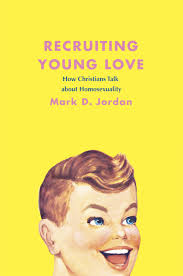 Recruiting Young Love: How Christians Talk about Homosexuality
Recruiting Young Love: How Christians Talk about Homosexuality
by Mark D. Jordan
University of Chicago Press
273 pages, $35.
EARLY in Gore Vidal’s novel The City and the Pillar is a scene that gay men who have read the book remember vividly. Two close friends, Bob and Jim, have gone camping. Bob graduated from high school the day before; Jim is a year behind him. As night falls, the two boys, both athletes, remove their shirts and wrestle. Their contact suddenly turns sexual, and Vidal, in “poetic” language, implies that both reach orgasm. Afterwards, embarrassed, they repudiate the “kid stuff” that just happened, but through the rest of the novel Jim, who is gay, will search for Bob, who is not. Much of Recruiting Young Love, Mark Jordan’s seventh book on religion and homosexuality, is encapsulated in this scene.
Starting around 1900, adolescence came to be seen by psychologists as the moment in which we put on, in Jordan’s words, our “sexual character.” Adolescence is a period of fluidity, sexual experimentation, same-sex crushes, passionate first love. It is a time in which a sexual experience can be so powerful that we might seek to repeat it through the rest of our lives. For those who condemn homosexuality, the unsettledness of adolescent sexuality represents a grave danger. If our sexual character is not fixed at birth, young people can be recruited into a perverted lifestyle. Those in charge of the formation of adults—psychologists, ministers, and social activists—must make sure the young are protected from influences that would entice them to make the wrong choice about their sexual character.
Mark Jordan explores the ways in which American Christian churches and their allies have addressed the problem of homosexuality and the young, charting a progression from near silence to open discussion. He calls his book a work of “rhetorical criticism,” explaining that he’s interested in the ways we speak about homosexuality and how speech creates characters that embody changing positions in an ongoing debate. For centuries an obscene character, the sodomite, preoccupied Christian churches. Beginning with the writing of Krafft-Ebing, Havelock Ellis, and Freud at the end of the 19th century, new characters began to appear: the invert, the pervert, the homophile, homosexuals, gays, and, most recently, acronyms like GLBT. Jordan gathers his rhetorical sources from what he calls “the archive,” a slightly hazy term that includes interviews, oral histories, public speeches, and published works. This way of approaching the topic makes the book more challenging than a straightforward discussion of Christian doctrine about homosexuality. Does the extra effort it takes to read Recruiting Young Love pay off? For the most part, it does.
The book is rich with examples from the archive, some more interesting than others. The first chapter treats G. Stanley Hall’s 1904 book Adolescence, which connects the European psychologists who coined the term “homosexuality” to American efforts to manage adolescent sexuality. Hall initiated the characteristically American tradition of linking religion and psychology. The role of churches was to turn one character, pious boys, into another, manly men who would marry and sire children. Jordan demonstrates the continuity of some rhetorical characters, such as degenerate effeminates and Jesus as a “man of iron,” from Hall’s time to our own. He also debunks the claim that churches have been unchanging in their condemnation of sexual acts. The Christian rhetoric now used to condemn homosexuality was once also applied to nocturnal emissions, masturbation, and birth control. The language remains the same but the targets have shifted.
Another noteworthy chapter discusses two famous books published in 1948, the first Kinsey Report and Vidal’s The City and the Pillar. Both gave voice to hidden worlds. Jordan calls John Rechy’s City of Night (1963) “one of the great works of gay religion.” In it, a new character, the adolescent hustler, is also a religious pilgrim. The description of Troy Perry’s pioneering role in gay ministry and of his book, The Lord is My Shepherd (1972), is engrossing. Sections about other gay churches, such as the MCC, are less interesting, because the archive consists mostly of dry historical records. Jordan makes it clear John McNeill’s great work, The Church and the Homosexual (1988), represents the high point in the Catholic discussion of homosexuality. He devotes a chapter to Anita Bryant and her 1977 campaign in Dade County, subjecting to rhetorical analysis everything from her orange juice ads to her book on the threat of militant homosexuality. What stands out now is not so much her strident voice as how her bogus use of the motherhood character has been replicated by two recent “moms,” Sarah Palin and Michele Bachmann.
The richer the material Jordan finds in his archive, the more rewarding his rhetorical criticism. His treatment of religious education documents, the ex-gay movement, and the reaction to AIDS (which focuses on the adolescent Ryan White and ACT UP), while thoroughly researched and analyzed, is at times tedious reading. Jordan’s main challenge, however, is capturing his topic. Adolescents have seldom been allowed to speak for themselves. Even asking them about their sexual experiences has been forbidden. For the most part, we know this time of life through recollection in a memoir or recreation in fiction. Finding our sexual character may be an experience that can be known only privately or imaginatively, making generalizations by experts hit or miss. But certainly Jordan has written an enlightening book about how we have discussed this topic in America for the past sixty years.
Daniel Burr is an assistant dean at the University of Cincinnati College of Medicine, where he teaches in the medical humanities program.





